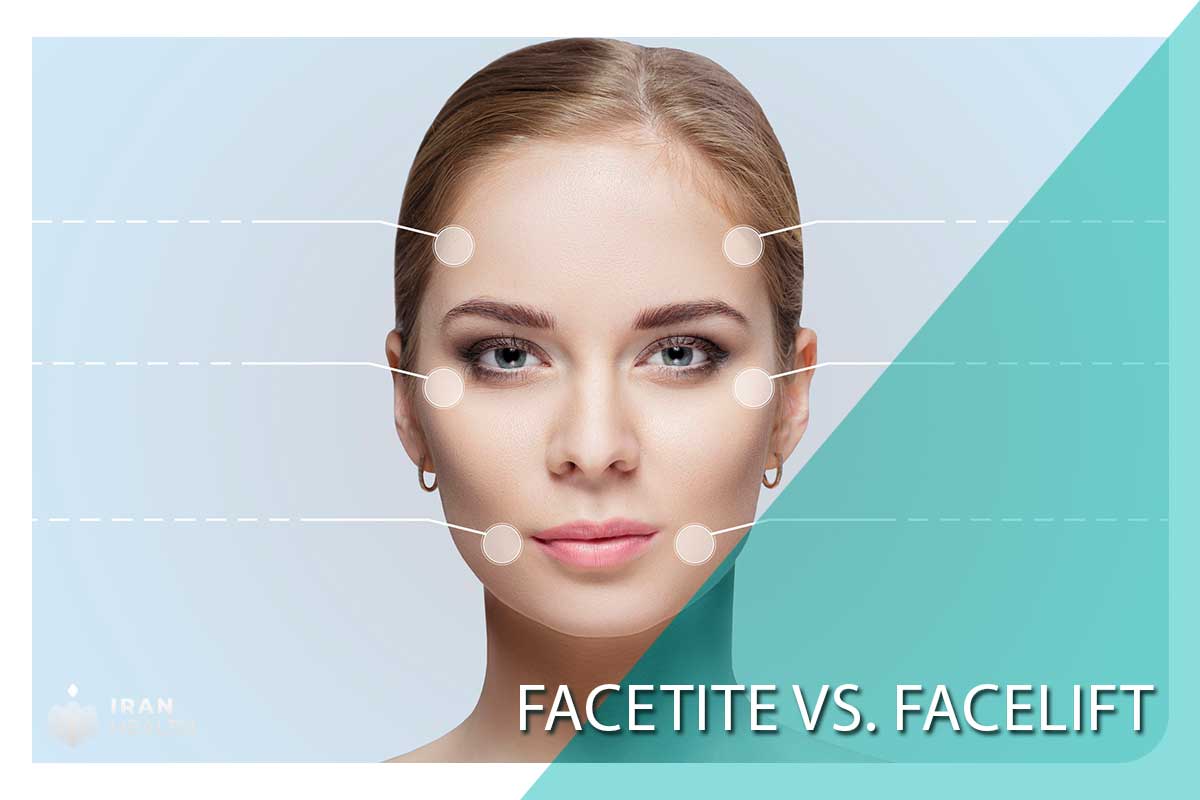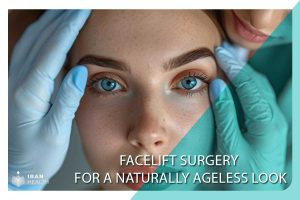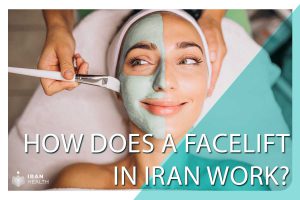Fast fact: FaceTite
| Category | Description |
| About | It targets sagging skin and wrinkles on the lower face with the help of radiofrequency waves and liposuction. It is an alternative to a traditional facelift. |
| Safety | Noted as safe, few incisions. Bruising and discomfort are expected in the first few days. Major side effects are rare but may include infections, bleeding, and scarring. |
| Convenience | The treatment is completed in a few hours, without the need for an overnight stay. Most people return to work within a few days. |
| Cost | The target area is the most important factor. Expect to spend at least a few thousand dollars. Financing plans and discounts may be available. |
| Efficacy | No other cosmetic procedure compares to a full facelift when it comes to anti-aging results. |
About FaceTite:
FaceTite is a cosmetic procedure that helps reduce sagging skin and wrinkles on the lower half of your face. The procedure involves using a small device that emits radio waves and liposuction to tighten the skin and remove unwanted fat. It’s a less invasive alternative to traditional facelifts that require larger incisions.
Tightening is a treatment that helps to tighten and firm up the skin. It works by heating the lower layer of the skin, which is mostly made up of collagen. This heat helps to break down fat and also triggers the production of new collagen. Collagen is a protein that helps to keep your skin firm in and elastic. Over time, this new collagen helps improve your skin’s appearance and make it look more youthful. Some patients even see an immediate improvement after the treatment.
Read more: Face Lift in Iran
FaceTite is commonly used:
- In the submental area, to reduce a double chin
- Along the jawline, to treat jowls and create a more defined jawline
- Across the cheeks and lower face, to contour and firm mildly sagging skin
- On the neck, a treatment that providers sometimes call NeckTite1
It also has two sister treatments, designed to target other areas:
- AccuTite (also known as Baby FaceTite) has a finer tip for tighter zones, like nasolabial folds (smile lines) and around the eyes.
- BodyTite uses the same radiofrequency energy technology with a larger handpiece, to treat excess fat and skin laxity on larger body areas, such as the abdomen, flanks, and arms, legs, and back.
Read more: Considering a Facelift? Let’s Talk About Your Options
How much does FaceTite cost?
The cost of FaceTite can vary depending on a few factors, such as how big the area you want to treat is, what your provider charges, and where you live. People have said that they have spent anywhere between $1,500 and $7,000 on the treatment. Since FaceTite is a cosmetic procedure, it usually isn’t covered by medical insurance. Before you get the treatment, make sure that you know all the costs upfront. You can also ask your provider about any financing or discount programs that are available.
FaceTite: how does it work?
FaceTite combines radiofrequency waves with traditional liposuction. First, your provider will apply local anesthesia to the treatment area and make a small incision. They’ll then insert a small device with electrodes to deliver radiofrequency waves that liquify fat cells. Next, they’ll use a thin cannula to suction out the melted fat. The entire procedure takes about an hour, depending on the size and number of areas treated. For example, a facelift typically takes about an hour, while a neck lift takes about an hour and a half.
What are the benefits of FaceTite?
FaceTite offers several advantages over more invasive cosmetic procedures, such as:
- Less downtime and recovery: You can go home the same day and resume your normal activities within a few days. You may experience some swelling, bruising, and discomfort, but these should subside within a week or two.
- Less scarring and risk of infection: The incisions are very small and heal quickly, leaving minimal or no visible scars. The risk of infection is also low, as the procedure is performed under sterile conditions.
- More natural-looking results: FaceTite does not alter the shape or position of your facial features but rather enhances them by removing excess fat and tightening loose skin. The results are subtle and gradual, as your skin continues to produce new collagen over time.
- More affordable than surgery: FaceTite is typically cheaper than a facelift, as it does not require general anesthesia, hospitalization, or extensive post-operative care.
What are the risks of FaceTite?
FaceTite is considered a safe and effective procedure with minimal risks or side effects. However, as with any cosmetic procedure, there are some potential complications that you should be aware of, such as:
- Bleeding and hematoma: Although rare, some bleeding may occur during or after the procedure, leading to the formation of a blood clot under the skin. This may require drainage or surgery to remove.
- Infection and inflammation: There is a small chance of developing an infection or inflammation at the site of the incision or the treated area. This may cause redness, pain, fever, or pus. You may need antibiotics or anti-inflammatory drugs to treat it.
- Nerve damage and numbness: The radiofrequency energy may damage some of the nerves in the face or neck, resulting in temporary or permanent numbness, tingling, or weakness. This may affect your facial expressions or sensations.
- Skin burns and blisters: The heat from the radiofrequency device may cause burns or blisters on the skin, especially if the device is not used properly or the skin is not cooled adequately. This may lead to scarring or pigmentation changes.
- Asymmetry and irregularities: The results of FaceTite may not be uniform or symmetrical, depending on the amount of fat removed, the skin elasticity, and the healing process. You may notice some lumps, bumps, or unevenness in the treated area.
How to prepare for FaceTite?
Before undergoing FaceTite, you should consult with a qualified and experienced provider who can assess your suitability, expectations, and goals. They will also explain the procedure, the risks, and the aftercare instructions. You should ask them any questions you have and review their portfolio of before and after photos.
You should also follow some pre-operative guidelines, such as:
- Avoid smoking, drinking alcohol, and taking blood-thinning medications or supplements for at least two weeks before the procedure, as these can increase the risk of bleeding and complications.
- Inform your provider of any medical conditions, allergies, or medications you have, as these may affect the anesthesia or the outcome of the procedure.
- Arrange for someone to drive you home and stay with you for the first night, as you may feel groggy or uncomfortable after the procedure.
How long does FaceTite last?
Just so you know, FaceTite results aren’t permanent. As you age, your skin will lose elasticity over time. However, if you maintain a healthy lifestyle and stick to a good skincare routine, you can expect the results to last for a few years. To keep your skin looking great, make sure to:
It’s important to protect your skin from the sun by using sunscreen, and wearing hats and sunglasses. To keep your face looking good and avoid weight changes that can affect the shape of your face, it’s important to follow a healthy diet and exercise regularly. Using good quality skincare products can also help keep your skin hydrated and nourished. You may also consider getting touch-up treatments or other procedures, like fillers, Botox or lasers, to improve or prolong your results.
FaceTite vs. other facial rejuvenation treatments
FaceTite, however, is not suggested as the only option to restore the youthfulness and vitality of your skin. Depending on your needs and preferences, you may also consider other treatments, such as:
- Facelift. If you’re looking to address signs of aging, there are different treatments to consider. One option is a facelift, which is a surgery that involves making cuts around the ears and hairline, lifting and repositioning the underlying muscles and tissues, and removing extra skin. This procedure is more suitable for people with more severe aging signs, such as deep wrinkles, sagging jowls, and loose skin around the neck. However, it also requires longer recovery time, higher cost, and leaves more visible scars compared to another treatment called FaceTite.
- Ultherapy. Ultherapy and Thermage are two non-surgical cosmetic procedures that can help tighten and firm up the skin on your face and neck. These procedures use different types of energy to heat the deeper layers of your skin, which stimulates collagen production and helps improve the appearance of mild to moderate skin sagging. However, it’s important to note that these procedures do not remove fat or change the shape of your face. Ultherapy usually requires multiple sessions and may cause more discomfort than Thermage, but both procedures can help improve the look of your skin without surgery.
- Thermage. This is another non-invasive procedure that uses radiofrequency energy to heat and tighten the skin on the face and neck. Thermage can also improve the appearance of mild to moderate skin laxity, but it does not remove fat or contour the face. It also requires multiple sessions, has less predictable results, and may cause more pain and discomfort than FaceTite.
Conclusion
FaceTite is a cool cosmetic procedure that can make you look younger and fresher by removing fat and tightening the skin on your face and neck. It’s like a facelift, but not as scary and expensive.
You don’t need to worry about scars and recovery time as much as with surgery. However, it’s not for everyone and has some risks and limitations. So, it’s a good idea to talk to a qualified and experienced provider first to see if FaceTite is right for you. We will be happy [as a provider of Medical tourism services] to help you with the whole process.



